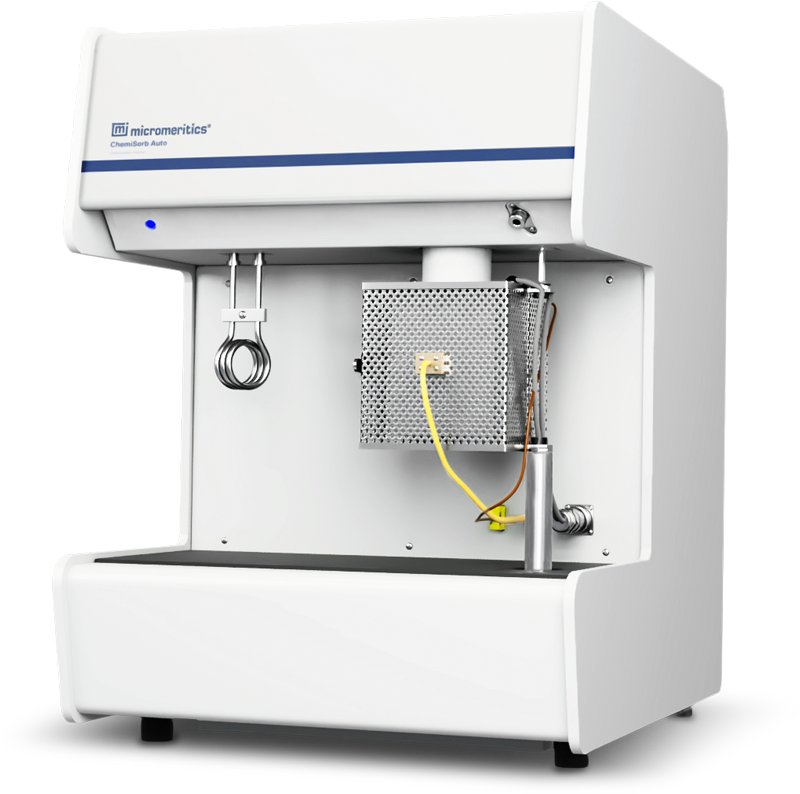ChemiSorb Auto sets a new standard in chemisorption:+/-1 % repeatability, ultra-low void volume and automated workflows. Stop compromising: only the ChemiSorb Auto delivers results no rival can match.

The Micromeritics ChemiSorb Auto is a compact, fully automated chemisorption analyzer designed to deliver high-precision, repeatable results for heterogeneous catalysts.
Whether you’re conducting temperature-programmed experiments or pulse chemisorption analyses, the ChemiSorb Auto offers reliable performance, affordable access, and unmatched ease of use – all in a benchtop footprint.

Loop Pressure Measurement
Patented Blending Valve
Minimal Internal Gas Volume
Highly Sensitive Linear Thermal
Conductivity Detector (TCD)
Forced Air Cooling
Dynamic Clamshell Furnace
8 Total Gas Inlets
Loop Pressure Measurement
Exact quantities of gas dosed to the
sample are known, ensuring repeatability within +/-1%.
Patented Blending Valve
Allows precise gas blending and
multi-point automatic gas calibrations.
Minimal Internal Gas Volume
Assures high resolution, fast detector
response, and reduces error when
calculating gas volumes.
Highly Sensitive Linear Thermal
Conductivity Detector (TCD)
Assures the calibration volume remains constant over the full range of peak amplitudes so the area under the peak is directly proportional to the volume of gas reacted.
Forced Air Cooling
Cools the furnace temperature rapidly down to near ambient (500°C to 50°C in 30 minutes), reducing analysis time and increasing throughput.
Dynamic Clamshell Furnace
Provides temperature control up to 1000°C and controlled heating from 1 to 100°C at a linear rate with minimal temperature overshoot.
8 Total Gas Inlets
Four each for carrier and loop gases fed to the system with two high-precision mass flow controllers.
3rd Party Safety Tested and Approved
CE Certified with NRTL marking and CB scheme validation, ensuring high quality and operator safety
ChemiSorb Auto is redefining routine chemisorption analysis with a compact, automated benchtop solution that delivers high-performance results—without the complexity or cost of traditional systems. Designed for labs that demand reliability and efficiency, ChemiSorb Auto empowers researchers in both academic and industrial settings to qualify catalysts and conduct TPx experiments with confidence.
The ChemiSorb Auto provides core chemisorption capabilities at a price point accessible to academic and industrial labs alike.
Temperature Programmed Reduction (TPR)
Rapidly transition from experimental data to material characteristics with Micromeritics’ own MicroActive data analysis software.
Get all the answers you need with:
Determining the active gas concentration in the mixture with an automatic calibration procedure is a breeze. ChemiSorb Auto will automatically mix the inert gas feed from the carrier MFC with the active gas feed from the loop MFC via the patented blend valve. This is done in a stepwise function across a range of concentrations, allowing the user to apply the saved calibration to a variety of sample data sets. Linear and polynomial fits are applied to the curve with correlation coefficients >0.995.
Hydrocracking catalysts typically composed of metal sulfides (nickel, tungsten, cobalt, and molybdenum)...
+The water gas shift reaction is an important element in the hydrogen...
+Fischer–Tropsch synthesis converts syngas into sustainable fuels, with cobalt and iron catalysts...
+Catalysts containing platinum, rhenium, tin, etc. on silica, alumina, or silica alumina...
+Catalysts such as small-pore zeolites (mordenite and ZSM-5) containing noble metals (typically...
+Manganese, cobalt, bismuth, iron, copper, and silver catalysts used for the gas-phase...
+Catalysts like palladium, nickel, and platinum rely on chemisorption to activate hydrogen...
+Acid catalysts such as zeolites are used to convert large hydrocarbons to...
+| Temperature | Ambient to 1000 °C |
| Temperature Ramp Rates | -100 °C to 400 °C: up to 100 °C/min |
| Carrier Gases | 4 inlets: H2, O2, He, Ar, H2/Ar, and more |
| Analysis (loop) Gases | 4 inlets: He,H2, CO, O2, N2O, NH3/He, and more |
| Analysis Types | Pulse Chemisorption |
| Optional Capabilities | Detection by Mass Spec |
Provided specifications were valid as taken from available documents at time of publication. These specifications may change without notice and are only provided as a general reference
Request a quote or talk to an expert for more information